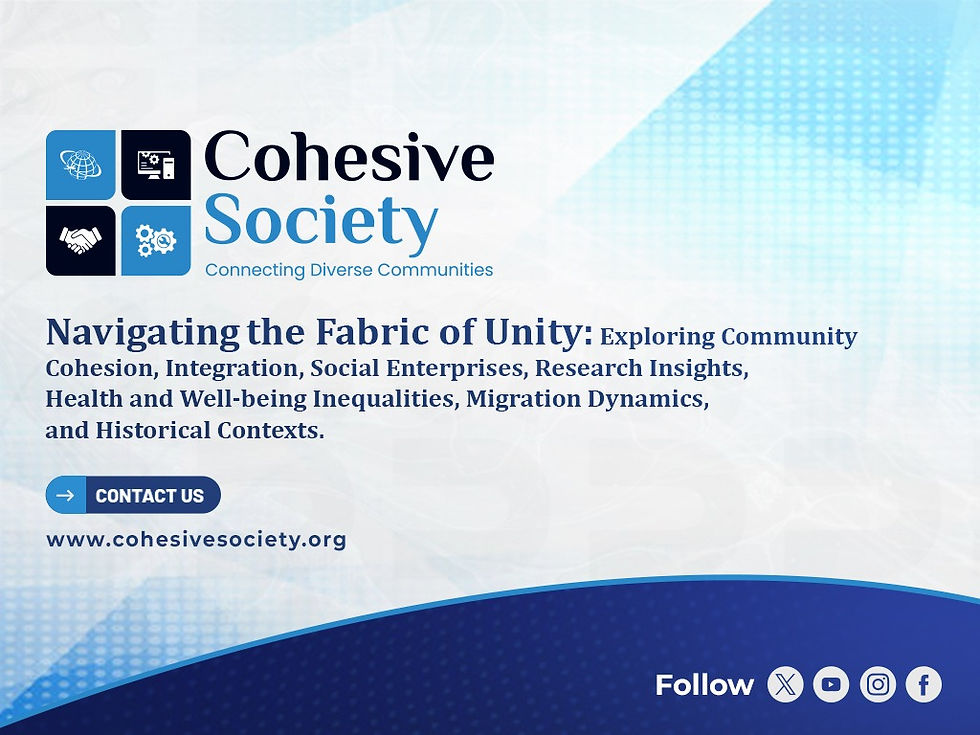The BAME youths in Higher Education in the UK
- Cohesive Society

- Apr 25, 2022
- 3 min read
Updated: Mar 29, 2024

A well-educated community, sufficiently equipped with knowledge and skill is not only needed to back economic growth but also is a prerequisite for growth to be inclusive and all-encompassing as it is the educated and accomplished person who can stand to gain advantage most from the employment prospects which growth will offer.
It can be seen that ethnic minority youths remain lacking in the education sector in the UK. Learners from a Black, Asian, and Minority Ethnic (BAME) community are more susceptible to withdrawing from their undergraduate courses in the UK. Therefore, it is essential to investigate withdrawal experiences and outlooks that are associated with the BAME population of students to increase the retention rate of students and attain success. Withdrawal rates in Higher education (HE) in the UK show fewer Black, Asian, and minority ethnic (BAME) students (approximately 86.8%) in comparison to White entrants (recorded to be 91.3%).

Image: Analysis of experiences of BAME youths
During the period 2003-2004, the university representation rate of BAME has increased from roughly 14.9% to 24% in 2017-2018. However, the BAME rates of withdrawal have also escalated leading to implications for individuals as well as society on the whole. As learners from BAME backgrounds have a higher propensity to withdraw from the undergraduate level of education, it is essential to focus on this group and ensure higher student retention. Despite some improvements logged in the last two decades, the rates of inequalities have continued to exist and have failed to react to the significant development in the scholastic outcomes of the ethnic minority class.

Image: Inclusivity
To attain the development in the general learning experiences of BAME students, it is important to identify the core issues that have prompted the negative learning experiences of BAME students by offering them a platform for communication and for their voices to be heard. It will also be extremely important to work through the detected problems with the learners to transform these into opportunities and constructive outcomes.
Youths in the BAME community need to be able to attain excellence and be accepted in educational spaces, without being regarded as someone special in comparison to others. To attain the highest level of improvement in the learning experiences of students in the BAME Community, varied levels of support systems need to collaboratively work together. With concentrated national attention on motivating the broader population to enter Higher Education, a lesser amount of focus has been given to the experiences individuals encounter once entered the sphere of higher education. It cannot be presumed that all the learners are well equipped to cope with all the difficulties and challenges faced with higher education studies, primarily designed as an opportunity for a few privileged sections, which is backed by the variances in rates of withdrawal across different populaces. Therefore, simply focusing on increasing the rates of intake of BAME learners into higher education institutions can be considered to be an unproductive measure to attain diversity, while institutional transformations are also not prioritized.
Thus, in this regard, it is extremely important to concentrate on the development of varied higher education exercises attending to the requirements of a more diversified population which again might be assisted using the tenets and doctrines of the Critical Race Theory (abbreviated as CRT).
CRT refers to an analytical framework that examines societal inequity and discrimination perpetuated through racism. The international approach of CRT can be used by scholars to assess educational research and other academic practices, counting societal incongruences in higher education. The doctrines of CRT might help higher education institutions in terms of the growing success of diversity, variety, and inclusivity of BAME learners. Particularly, counter-storytelling can be considered to be an important doctrine of CRT, which targets to substantiate racial experiences of various minority populations through analysis of the majority population, using personal descriptions and accounts. Counter storytelling as a systematic tool based on the CRT can help in exploring experiences of racism and can be further used in educational research. Counter stories as an analytical tool based on the CRT to explore experiences of race and racism in education and further demonstrated how CRT can be used in future educational research.




Comments